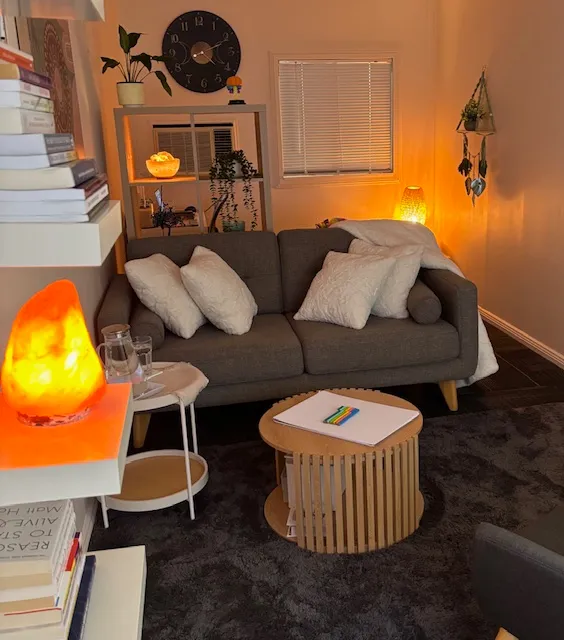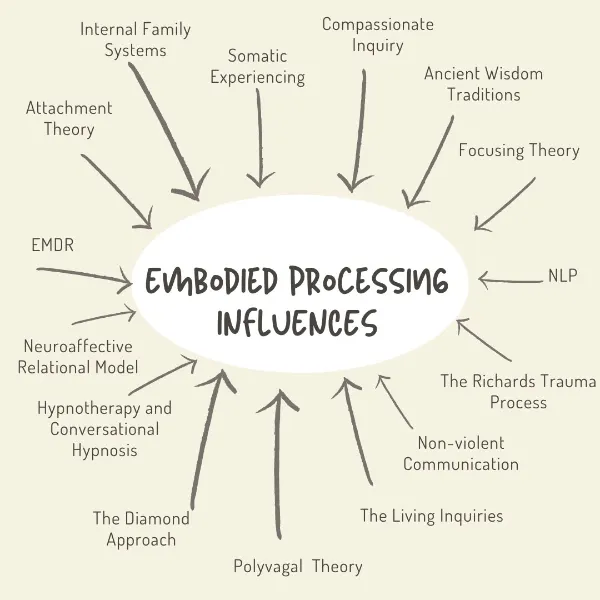Embodied Processing
Embodied Processing is a therapeutic approach that focuses on helping you to be with your direct experience, allowing you to connect with your body to process emotions, trauma, and life experiences. By tuning into the physical sensations that arise within your body, we can begin to gently release stored tension and create more space for healing and growth. This approach recognises that the body holds much of what we’ve experienced, and by working directly with these sensations, we can achieve deeper, more lasting healing.
As a Level 2 Certified Embodied Processing Practitioner, I guide you through this process with care and support, helping you build a stronger connection between your mind, body, and soul. In our sessions, you can expect to explore your inner world through a felt sense, allowing emotions to move and transform in ways that talking alone cannot achieve. This method fosters resilience, clarity, and a grounded sense of well-being, helping you navigate life’s challenges with greater ease and self-compassion.
This approach offers a gentle yet powerful way to work with patterns of overwhelm, disconnection, and stuckness. Rather than analysing or intellectualising your experiences, we bring attention to what is happening in the present moment, supporting your body’s natural capacity to process and integrate. It can be particularly helpful when words are hard to find, or when past experiences continue to shape how you feel and respond today. Through embodied presence, we honour your story while also creating space for something new to emerge.
At the heart of this work is the intention to grow your capacity to stay with direct experience, especially the parts of your experience that may have previously felt too intense, too painful, or too uncomfortable to be with. By building this capacity gradually and with care, you develop the inner resources needed to face and process what arises, rather than avoid or disconnect from it. Over time, this strengthens your sense of agency and safety within yourself, allowing for a deeper sense of integration and wholeness.
What to Expect During a Session
Sessions are paced with respect for your nervous system and unique experiences. Together, we slow down and tune into your body’s cues, allowing space to notice what is arising, whether that’s a tightness in your chest, a heaviness in your stomach, or a sense of numbness or disconnection. There is no pressure to ‘fix’ or push through these sensations. Instead, we bring gentle curiosity, creating the conditions for your system to process safely and at its own pace.
You might be invited to close your eyes or soften your gaze, and to track sensations, emotions, images, or thoughts as they emerge. Grounding techniques, resourcing, and breath awareness are often used to support safety and regulation throughout the process.
Unlike traditional talk therapy where the focus is primarily cognitive, this work encourages you to stay connected to the body’s felt sense, the subtle shifts, impulses, and movements that hold valuable information for healing. Sometimes there may be long pauses, spaciousness to feel into what’s there, or gentle guidance to help you stay with a particular sensation without overwhelm.
Each session is collaborative, and you remain in control at all times. We move at a pace that feels right for you. My role is to support and guide, not to interpret or impose meaning. The focus remains on cultivating safety, presence, and connection, building your capacity to stay with yourself, even in the more difficult places.
Over time, this process can support you to feel more regulated, more connected to yourself, and more able to respond to life rather than react from old patterns. It invites you to meet yourself with compassion, curiosity, and kindness, reconnecting with yourself in your healing journey.
Influences and Foundations of This Approach
Embodied Processing is grounded in a rich tapestry of trauma-informed and somatic-based methodologies, drawing on a range of well-respected theories and practices that inform the way we work together. This approach honours the body’s role in holding and processing life experiences, while also recognising the importance of curiosity, safety, and connection in supporting meaningful healing.
Key influences include Somatic Experiencing, developed by Dr Peter Levine, which focuses on completing the body’s natural responses to stress and trauma, and Internal Family Systems (IFS) by Dr Richard Schwartz, which brings gentle attention to the different parts of self, supporting integration and self-leadership. The work of Gabor Maté’s Compassionate Inquiry informs the way we explore the links between early experiences, emotional patterns, and the body, with a focus on meeting these patterns with compassion rather than judgement.
Understanding the nervous system through Polyvagal Theory by Dr Stephen Porges shapes how safety, connection, and regulation are supported throughout the process. The insights of Bessel van der Kolk, particularly around the body’s role in trauma recovery, further reinforce the importance of working somatically rather than relying on words alone.
This approach is also influenced by Attachment Theory, introduced by John Bowlby and Mary Ainsworth, which highlights how our early relational experiences shape nervous system responses and emotional well-being. We consider how these patterns may show up in the body and relationships today, and how healing can occur through embodied presence and connection.
Additional therapeutic frameworks that inform Embodied Processing include:
- Neuro-Linguistic Programming (NLP) by Richard Bandler and John Grinder, offering tools for exploring the language of the mind and body connection.
- Conversational Hypnotherapy, drawing on the work of Milton Erickson, supporting change through natural, unconscious processes.
- NeuroAffective Relational Model (NARM) by Laurence Heller, which focuses on developmental trauma and the importance of relational repair.
- Kiloby Inquiries by Scott Kiloby and The Living Inquiries, co-created by Fiona Robertson, Julianne Eanniello, Colette Kelso, and Lisa Meuser, which explore inquiry-based, somatic mindfulness to untangle unconscious beliefs and emotional pain.
- Focusing by Eugene Gendlin, which emphasises listening to the body’s felt sense as a pathway to insight and healing.
- The Diamond Approach by A. H. Almaas, offering a spiritual and psychological framework that integrates personal development with deeper self-awareness.
- The Richards Trauma Process (TRTP) developed by Judith Richards, known for its structured approach to trauma resolution.
By weaving together these influences, this work remains flexible, person-centred, and responsive, supporting your unique process while grounded in the latest understandings of trauma, nervous system health, and human development. This integrated approach allows for a deep and compassionate exploration of the ways your body, mind, and experiences interconnect, creating the space for lasting change and embodied healing.
Schedule an Appointment
It would be my privilege to walk alongside you on your journey to a more fulfilling life. I offer a free 15-minute phone or video consultation to ensure I am the right fit for your needs.
Book Appointment





